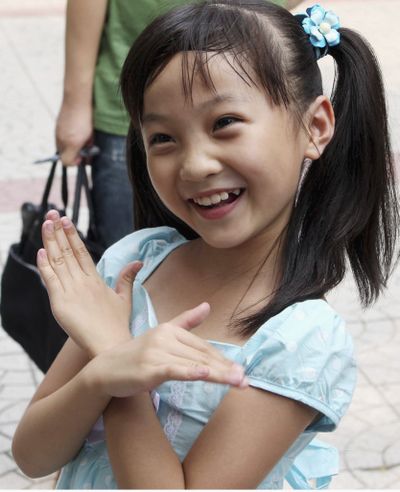Lip-syncing sparks debate
Chinese Internet abuzz over show

BEIJING – China’s $100 million Olympics opening ceremony Friday, the most expensive and lavish in history, set a standard for spectacle and pizazz and impressed viewers around the world.
As the afterglow gives way to the thrill of competition, however, some Chinese have questioned the expense, aesthetics – and why organizers apparently misrepresented some elements in their quest for perfection.
When Lin Miaoke, 9, belted out “I Sing for My Country” as the Chinese flag entered the national stadium, she became an instant celebrity and was quickly dubbed a “smiling angel.” But she apparently wasn’t the one singing. Chen Qigang, the ceremony’s music director, told state broadcaster CCTV that the voice hundreds of millions of people heard was that of 7-year-old Yang Peiyi. Yang had the voice and was supposed to perform but was yanked at the last minute because she had crooked teeth.
“It was for the national interest,” Chen told CCTV. “The child on camera should be flawless in image, internal feelings and expression.”
The Chinese Internet quickly lighted up, with many online users condemning the apparent bait and switch at the government’s big show.
“Fake singing for national honor? What kind of lessons are we giving such a small child?” asked an anonymous posting on 163.com, a news portal. “Is this national honor or national shame?”
China’s propaganda ministry moved in Tuesday, deleting many online discussion entries and blocking access to video links showing Lin’s lip-syncing.
Another sleight-of-hand involved the fireworks display that exploded the length of Beijing at the culmination of the ceremony. The display was real, involving 29 pyrotechnic “footprints” exploded sequentially from Tiananmen Square to the Olympic Village.
But the 55-second version that most TV viewers saw was an animated three-dimensional studio re-creation, Gao Xiaolong, visual effects team leader at the Crystal Stone animation company, told the Beijing Times. Only the last “footprint” closest to the stadium known as the Bird’s Nest was filmed in real time.
“Most viewers thought these were live shots, so our work achieved its effect,” Gao said proudly.
Gao said planners earlier decided that capturing all 29 “footprints” on camera would be too difficult. So the studio spent nearly a year crafting the clip, which was inserted into the live coverage.
To make it as seamless as possible, Crystal consulted with the weather bureau to re-create Beijing haze at night, Gao told the newspaper, and included a slight shaking to simulate shooting from a helicopter. The company declined to comment Tuesday.
Many viewers didn’t realize that most of the 15,000 “volunteer” performers were from the army or paramilitary.
Internet postings speculated on whether the revelations of lip-syncing and animated fireworks would topple careers. Enormous secrecy surrounded the lead-up to the ceremony. Korean television reporters were chastised for leaking footage of a practice run, while those working on the production were told they faced seven years’ imprisonment for disclosing details.
Kang Xiaoguang, a social science researcher with the Chinese Academy of Science, said it was good that China had more online debate, a sign the society is maturing, but he added that the singing and fireworks misrepresentations, if true, are disconcerting.